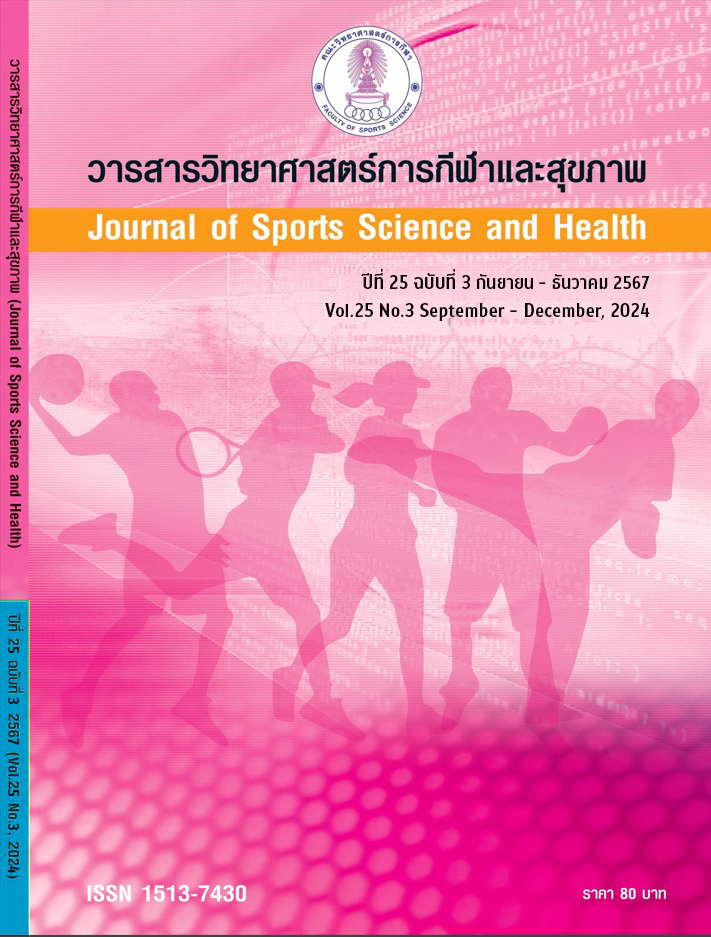THE EFFECTS OF CIRCUIT TRAINING PROGRAM ON AGILITY IN MALE VARSITY VOLLEYBALL PLAYERS
Main Article Content
Abstract
Purpose
The current study aimed to determine and compare the effects of circuit training programs on agility in male varsity volleyball players.
Methods
Forty male varsity volleyball players, aged 19-22 years old, from volleyball club of Thailand National Sports University, Sisaket Campus, were recruited for participation. They were randomly allocated by the Illinois agility test scores into two groups including a circuit training group (n=20) and control group (n=20). Agility was measured before and after intervention by Semo test. The circuit training consisting of 8 stations including (1) lateral skater jump with quick flip jump (2) single leg high knee (3) step-box and jump (4) hexagon (5) step high knee with resistance bands (6) agility ladder drills straddle hops (7) three shuttle run and (8) nine – square 20 sec was applied to the participants for 3 days a week for a total of 8 weeks while the control group followed a regular training program. A paired sample T-test was used to compare the data within the group while independent sample T-test was employed to compare the data between groups. The statistical significance of all tests was set at P-value < 0.05.
Results
After 8 weeks of training, it was found that the mean agility of male volleyball players before training was 18.01±1.01 seconds and after training was 16.36±0.42 seconds, which was significantly different from before training at the .05 level. When comparing groups after training, it was found that the experimental group trained with the circuit training program had a faster mean agility than the control group at the .05 level.
Conclusion
Results 8 weeks of circuit training program helps develop Improved agility in male volleyball players.
Article Details

This work is licensed under a Creative Commons Attribution-NonCommercial-NoDerivatives 4.0 International License.
References
Apipolchan, P. (2018). The effects of circuit training program on physical fitness of military preparatory students. Bachelor's thesis, Sports Science Program, Faculty of Sports Science, Chulalongkorn University. Bangkok.
BarBend. (2023). The 10 best agility training exercises for strength athletes. Retrieved from website: https://barbend.com/best-agility-training-exercises/
British Journal of Sports Medicine. (n.d.). Single-leg exercises to enhance strength and balance in athletes. British Journal of Sports Medicine. Retrieved from website: https://bjsm.bmj.com/content/56/9/490
Craig, A. (2004). Neuromuscular control during agility movements. Journal of Sports Science, 7(2), 45-58.
Johns, A., Smith, B., and Lee, C. (2018). The importance of speed and agility in volleyball: a review. Journal of Sports Science, 15(3), 45-58.
Johnson, M., and Lee, T. (2018). Effects of circuit training on agility and injury prevention in sport. International Journal of Sports Fitness, 12(2), 101-115. doi:10.5678/ijsf.2018.00101
Krabuanrat, C. (2014). Science of Coaching. Bangkok: Sitthanacopy Center.
Kamutsri, T., Trirat, A., Sriwilai, C., and Naepsanit, J. (2015). The physical fitness norms of Thai university athletes. Retrieved from website: https://mucomplex.mahidol.ac.th/fitnesstest/manual/pdf/FitnessTestOnWeb_2558.pdf
Mathisen, G. E., and Svein, S. (2018). Effects of SAQ training on agility and speed in athletes. PLOS ONE, 13(11), e0208057. https://doi.org/10.1371/journal.pone.0208057
Paso, P., Phonyiam, P., Thanommek, A., Sarakol, K., and Chuwet, P. (2023). Effects of the multiple movements training program on male volleyball players’ leg muscle abilities and agility. Journal of Sports Science and Health Innovation, Rajabhat University Group of Thailand, 2(1), 41-53.
Pianchob, W. (2005). Principles and Methods of Physical Education. Bangkok: Thai Watthana Panit.
Rushall, B. S., and Pyke, F. S. (1990). Training for sports and fitness. New York: Macmillan Education.
Sakunchit, P., and Khamwong, P. (2016). Effect of circuit training on agility, muscular endurance and strength of table tennis players. Graduate Research Journal, 7(1), 115-124.
Sinbuma, B. (2015). The effects of integrated training on the speed and flexibility of elementary school volleyball players. Master's thesis, Physical Education Program, Nakhon Sawan Rajabhat University. Nakhon Sawan.
Seelamad, S. (2004). Principles of sports coaching for sports instructors. Bangkok: Chulalongkorn University Press.
Songtrakoon, S., and Santhirachan, W. (2020). Effects of spider web table and nine square training programs on muscle strength, agility and speed of volleyball players. Chonburi: Burapha University.
Smith, B., Johnson, C., and Williams, D. (2020). Sprinting and quick movement in volleyball: strategies and training methods. International Journal of Volleyball Research, 22(1), 112-125.
Smith, J. A., and Brown, R. L. (2017). The effect of progressive resistance training on muscle strength and power in athletes: a review. Journal of Sports Science and Medicine, 16(3), 345-356.
Sakthivel, S., and Vaithiyanathan, K. (2022). Impact of circuit training on muscular strength and leg explosive power among volleyball players. Journal of Positive School Psychology, 6(10), 3937-3939.
Twist, P. (1996). The role of neuromuscular control in agility training. International Journal of Sports Physiology and Performance, 10(3), 112-125.
Wechaphaet, C., and Palawiwat, K. (1993). Physiology of exercise (4th ed.). Bangkok: Thammakamol Printing House.


